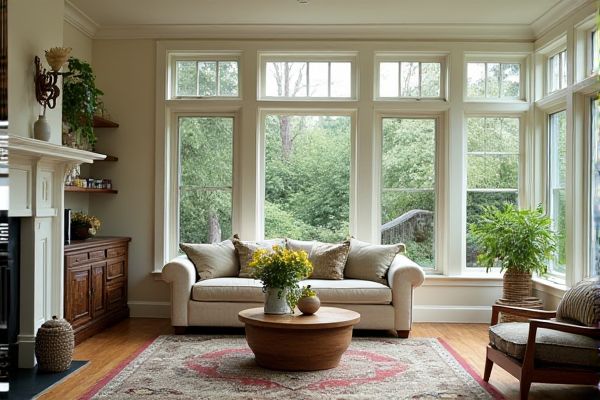
Modern sunroom design features sleek lines, large glass panels, and minimalistic elements that maximize natural light and create a seamless connection with the outdoors, while traditional sunrooms often incorporate classic architectural details, cozy furnishings, and warm color palettes to evoke a timeless, inviting ambiance. Explore this article to discover how Your choice between modern and traditional sunroom styles can transform your living space.
Table of Comparison
| Feature | Modern Sunroom Design | Traditional Sunroom Design |
|---|---|---|
| Architecture | Minimalist lines, large glass panels, flat or low-pitched roofs | Ornate frames, pitched roofs, divided light windows |
| Materials | Aluminum, steel, tempered glass, composite materials | Wood frames, single-pane glass, decorative trim |
| Lighting | Maximized natural light with floor-to-ceiling windows | Standard window sizes with limited glazing |
| Insulation & Energy Efficiency | High-performance glass, thermal breaks, energy-efficient HVAC | Limited insulation, single-pane glass, basic HVAC |
| Color Palette | Neutral, monochrome tones like white, gray, black | Warm, earthy tones with muted pastels |
| Functionality | Multi-purpose spaces, integration with smart home tech | Primarily seasonal living or decorative use |
| Maintenance | Low-maintenance materials, easy to clean | Requires regular painting, sealing, and upkeep |
| Cost | Higher upfront investment, long-term energy savings | Lower initial cost, potential higher maintenance expenses |
Introduction to Sunroom Design
Sunroom design has evolved from traditional styles characterized by ornate woodwork and classical symmetry to modern aesthetics emphasizing clean lines, expansive glass panels, and minimalistic frames. Modern sunrooms often incorporate energy-efficient materials such as double-glazed windows and aluminum or uPVC framing, enhancing thermal insulation and durability compared to traditional wooden structures. The shift in design reflects growing preferences for maximizing natural light, seamless indoor-outdoor integration, and sustainable architecture in contemporary home additions.
Defining Modern Sunroom Aesthetics
Modern sunroom aesthetics emphasize clean lines, minimalist design, and large expanses of glass that maximize natural light and outdoor views. Materials such as aluminum frames and sleek composite panels replace traditional wood, offering durability and a contemporary appearance. The integration of smart technology for climate control and automated shading further distinguishes modern sunrooms from their traditional counterparts.
Characteristics of Traditional Sunrooms
Traditional sunrooms feature classic architectural elements such as wood framing, large multi-pane windows, and pitched or gabled roofs that blend seamlessly with older home styles. They often utilize warm, natural materials like hardwood floors and brick accents to create a cozy, inviting atmosphere. Emphasis on symmetry, ornate trim, and detailed moldings distinguish traditional sunrooms from modern minimalist designs.
Material Choices: Modern vs Traditional
Modern sunroom design often incorporates aluminum frames and large glass panels for maximum light and sleek aesthetics, utilizing materials like tempered glass and composite siding for durability and minimal maintenance. Traditional sunrooms typically feature wood frames and classic double-pane windows, offering a warmer, more rustic appearance but requiring more upkeep to prevent weathering and decay. The choice between modern and traditional materials significantly impacts the sunroom's insulation, longevity, and visual appeal.
Window Styles and Natural Light
Modern sunroom designs emphasize expansive floor-to-ceiling windows and minimalist frames to maximize natural light and create seamless indoor-outdoor connections. Traditional sunrooms typically feature divided light windows with decorative muntins, offering a classic aesthetic but often limiting unobstructed views and sunlight. Advances in glazing technology in modern designs enhance energy efficiency while allowing larger window panes compared to the smaller, multi-pane configurations common in traditional styles.
Furniture and Decor Trends
Modern sunroom design emphasizes minimalistic furniture with clean lines, neutral color palettes, and multifunctional pieces that maximize space and comfort. Traditional sunroom decor favors wicker or wooden furniture featuring intricate patterns, warm earth tones, and classic accessories like floral cushions and vintage rugs. Both styles incorporate plants, but modern designs use sleek planters and sculptural greenery, while traditional spaces showcase abundant greenery in rustic pots for a cozy ambiance.
Color Palettes: Contemporary vs Classic
Modern sunroom design favors neutral color palettes such as whites, grays, and muted earth tones, creating a clean, minimalist aesthetic that highlights natural light and architectural lines. Traditional sunrooms often incorporate warmer, richer colors like creams, deep greens, and soft pastels, evoking a cozy, inviting atmosphere with a timeless charm. Your choice between contemporary or classic color schemes will significantly influence the sunroom's overall mood and compatibility with the rest of your home.
Energy Efficiency and Sustainability
Modern sunroom designs emphasize energy efficiency through advanced insulation, double or triple-pane low-E glass, and solar control coatings that reduce heat loss and gain. Traditional sunrooms often rely on single-pane windows and minimal insulation, leading to higher energy consumption and less sustainability. Selecting a modern sunroom for Your home helps reduce utility costs and environmental impact while enhancing comfort year-round.
Integration with Outdoor Spaces
Modern sunroom designs emphasize seamless integration with outdoor spaces through expansive glass walls, sliding doors, and minimalist framing that blurs the boundaries between indoor and outdoor environments. Traditional sunrooms often feature more ornate architectural details and separated window panels, creating a distinct enclosure rather than a continuous flow with the outdoors. This difference impacts natural light penetration, views, and accessibility, with modern designs prioritizing openness and multifunctional living areas connected to gardens or patios.
Choosing the Right Sunroom Style for Your Home
Selecting the right sunroom style for your home depends on balancing aesthetic preferences with functional needs. Modern sunrooms feature sleek lines, large glass panels, and minimalist frames that maximize natural light and offer seamless indoor-outdoor integration. Traditional sunrooms emphasize classic architectural details, cozy materials, and warm color palettes, providing a timeless, inviting space that complements historic or farmhouse-style homes.
 homyna.com
homyna.com